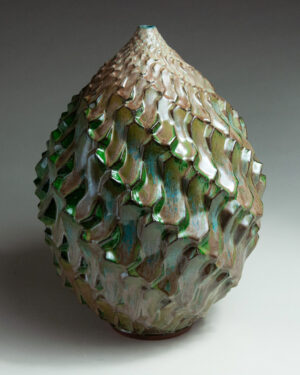Name
 ARTIST STATEMENT
ARTIST STATEMENT
My work as a ceramist has focused on the interplay of traditional forms and sculptural expression. I use the vessel form conceptually, because vessels have an inside, an inner dimension. An enclosed form is extroverted; it displaces space and interacts with its environment. Imagine the same enclosed form but with a small entrance to an interior. The form becomes introverted, self-contained; it has an existential presence connected to its mysterious inner space.
In the ancient world, vessels were used functionally, but also metaphorically in ritual and literature, employing some of the same ideas of interiority. Looking back to these antecedents, I treat the metaphor of the inner as a resonant subject matter for non-functional ceramic art pieces. Implied are the dichotomies between the inner and outer, the hidden and the seen, the created world and the ineffable mystery. Cutting through the wall and changing the angles of the various connecting planes in my complex tessellated patterns, I create deep relief, a dynamic movement that leads the eye to the inside of the vessel, opening a dialogue between the vessel’s outer planes and inner spaces.
An ongoing project is to use this visual language to explore human consciousness via the portrait in my “Refracted Journeys: Portraits” series. This series expands my concept of the “inside” of the vessel to the head and our notion of consciousness, implying the refracted nature of the psyche and its ineffable journey.
ARTIST BIO
Born in the Pacific Northwest, Judith Ernst studied studio art and political science at Stanford University. Living in South Asia after graduation, she was influenced by art from that region and became committed to creating art that had meaning. She did that by illustrating books. In 1995 she won a national award for The Golden Goose King. It was followed by an illustrated version of the Song of Songs in 2003.
In 2001 while visiting the Gulbenkenian Museum in Lisbon, she viewed their extensive collection of 17th-Century Turkish Iznik pottery. The overwhelming beauty of this collection suggested that “perhaps beauty is enough”. Returning home, she began learning ceramics. But she found that the vessel form, with its exterior and hidden interior, immediately suggested meaning and an ancient resonance. For her, “beauty” doesn’t exist without “meaning”, so she creates conceptual and even contemplative ceramic vessels, some now covered with words.




